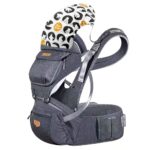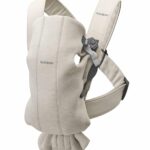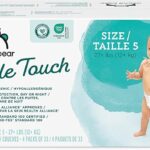Best Baby carriers for comfort are not just a tool; they are a blessing for parents. They make life easy and keep your baby close to your heart. With a baby carrier, you create a loving bond with your child while having the freedom to do many tasks.
Carrying your baby in a carrier helps you feel connected. It also allows your baby to feel safe and loved. This simple act can strengthen your relationship and bring many moments of joy.

Hands-Free Freedom
Parenting is busy. You need your hands for cooking, cleaning, or even relaxing. A baby carrier lets you multitask while keeping your baby close and happy.
Imagine folding laundry while your baby enjoys being snuggled against you. Or walking through a park while your little one takes in the world. A carrier makes this possible.
Best Baby Carriers for Comfort and Safe for Babies
Baby carriers are designed to keep your child safe. They provide a soft and secure place where your baby feels cozy. Many carriers are also ergonomic, meaning they help your baby sit in a healthy position. This is important for their growth and comfort.
Carriers are not just about convenience; they are about emotional health too. Holding your baby close helps them feel calm and builds trust. It also helps parents feel more connected to their child.
Types of Baby Carriers
There are many kinds of baby carriers. Each one has special features to meet different needs.
Wraps
Wraps are long pieces of soft fabric that you tie around your body. They give a snug and adjustable fit, perfect for newborns. Wraps are great for parents who like a close, skin-to-skin connection.
Pros:
- Custom fit
- Ideal for newborns
- Comfortable for long wear
Cons:
- Can take time to learn how to tie
- May feel warm in hot weather
Slings
Slings are like wraps but simpler. They go over one shoulder and create a pouch for your baby. They are quick to use and great for short trips.
Pros:
- Easy to wear
- Lightweight and portable
- Perfect for on-the-go parents
Cons:
- May put pressure on one shoulder
- Limited carrying positions
Structured Carriers
These carriers have straps and buckles. They are sturdy and offer great support for both babies and parents. Many structured carriers can be used for toddlers too.
Pros:
- Adjustable for comfort
- Suitable for older babies and toddlers
- Can be used in multiple positions
Cons:
- Bulkier than wraps or slings
- Higher cost

Traveling with Baby Carriers
Traveling with a baby can be challenging. A good baby carrier can make trips easier and more enjoyable.
Imagine walking through an airport without pushing a stroller. With a carrier, your baby stays close, and you can move freely. Baby carriers are perfect for exploring new places, hiking, or simply running errands.
Features to Look For in a Baby Carrier
Choosing the right carrier can feel overwhelming. Here are some features to look for:
- Breathable Fabric: A carrier with a stretchable and micro-vented lining keeps your baby cozy but cool.
- Adjustability: Carriers with adjustable straps grow with your baby, saving you money.
- Versatility: Some carriers let you carry your baby in different positions, like on your chest or back.
- Ergonomics: A good carrier supports your baby’s hips and spine. It should also be comfortable for you.
By considering these features, you can find a carrier that suits your lifestyle and your baby’s needs.
Best Baby Carriers for Long Journeys
When planning long trips, comfort is key—for both you and your baby. A high-quality baby carrier makes travel smoother, whether you’re on a plane, hiking a trail, or strolling through a busy city. Let’s explore the features that make baby carriers ideal for long journeys.
Comfort for Your Baby
Long trips can be tiring for babies, but a good carrier keeps them snug and happy. Look for carriers with:
- Soft Padding: A padded interior gives your baby a cozy seat. It helps prevent discomfort during long wear.
- Breathable Materials: Carriers with micro-vented fabrics allow air to flow, keeping your baby cool.
- Supportive Design: Carriers that ensure proper hip and spine alignment are essential. These designs help with your baby’s growth and comfort.
Comfort for Parents
Carrying your baby for hours can be hard on your body. That’s why choosing an ergonomic carrier is important. Features to consider include:
- Adjustable Straps: These let you customize the fit, ensuring even weight distribution.
- Lumbar Support: Some carriers offer extra padding for your lower back, reducing strain.
- Lightweight Design: A lighter carrier makes long trips less tiring for parents.
Versatile Carrying Positions
Babies grow quickly, and their needs change. The best baby carriers adapt to different stages of your baby’s life. Many carriers offer multiple positions, such as:
Front Carry (Facing In)
This is perfect for newborns and young babies. Your baby rests against your chest, feeling your warmth and heartbeat. It’s soothing and helps your baby feel secure.
Best For:
- Newborns and infants
- Napping on the go
Front Carry (Facing Out)
As your baby grows curious about the world, they’ll love facing outward. This position lets them see everything around them.
Best For:
- Babies 4–6 months and older
- Exploring new environments
Back Carry
Once your baby becomes heavier, carrying them on your back is easier. It’s great for longer walks or when you need full mobility.
Best For:
- Older babies and toddlers
- Hiking or long-distance travel
Hip Carry
The hip carry position is a natural way to hold your baby. It’s a good option for quick tasks or when your baby wants to be close but also see the world.
Best For:
- Babies who can sit up
- Short periods of carrying
Popular Baby Carrier Brands to Consider
If you’re wondering which carrier to choose, here are some trusted brands:
Chicco Soft & Dream Baby Carrier
This carrier is lightweight and offers multiple carrying positions. Its padded design ensures comfort for both parent and baby. The adjustable straps make it easy to switch between users.
Highlights:
- Soft, breathable lining
- Suitable for newborns and toddlers
- Great for short and long trips
Ergobaby 360
Known for its ergonomic design, the Ergobaby 360 supports your baby’s hips and spine. It offers four carrying positions and adjustable straps for parents.
Highlights:
- Wide, padded waistband for lumbar support
- Machine washable
- Ideal for everyday use
Tips for Using a Baby Carrier
Using a baby carrier may seem simple, but a few tips can make it even better:
- Practice First: Before heading out, practice wearing the carrier at home. This helps you get comfortable with the straps and buckles.
- Follow Weight Limits: Always check the carrier’s weight and age recommendations. Using a carrier incorrectly can be unsafe.
- Dress Appropriately: Choose lightweight clothes for both you and your baby, especially in warm weather.
- Check Positioning: Make sure your baby’s legs are in an “M” shape, with their knees higher than their hips. This ensures proper hip support.
- Take Breaks: If you’re on a long journey, take breaks to stretch and rest. Let your baby move around too.
The Benefits of Baby wearing
Baby wearing offers many benefits for both babies and parents:
For Babies
- Better Sleep: Babies often sleep better when carried close to a parent.
- Less Crying: Being close to a parent reduces stress and helps babies feel secure.
- Healthy Development: Proper carriers support your baby’s physical growth.
For Parents
- More Freedom: A carrier lets you keep your baby close while doing everyday tasks.
- Stronger Bond: Carrying your baby creates a special connection.
- Less Strain: An ergonomic carrier reduces back and shoulder pain.
Choosing the Right Carrier for You
There’s no one-size-fits-all answer when it comes to baby carriers. The best choice depends on your lifestyle, your baby’s needs, and your budget. Here are some final tips:
- Try Before You Buy: If possible, try different carriers to see which feels most comfortable.
- Read Reviews: Look for feedback from other parents to understand the pros and cons of each carrier.
- Consider Your Activities: If you plan to hike, look for a sturdy, supportive carrier. For quick errands, a sling might be better.
Caring for Your Baby Carrier
To ensure your baby carrier lasts and remains safe, it’s important to care for it properly. Here are some tips for maintenance:
Regular Cleaning
Babies can be messy, so it’s crucial to keep the carrier clean. Follow these steps:
- Check the Label: Always read the care instructions provided by the manufacturer.
- Spot Cleaning: For small stains, use a damp cloth with mild soap to clean the area.
- Machine Wash: If your carrier is machine washable, use a gentle cycle and air-dry it to prevent shrinkage.
Inspect for Wear and Tear
Over time, straps, buckles, and fabric can wear out. Inspect your carrier regularly to ensure it’s still safe to use.
- Check Straps: Look for fraying or weakened stitching. Replace the carrier if straps are damaged.
- Test Buckles: Make sure all buckles are working properly and hold securely.
- Examine Fabric: Look for holes or thinning areas in the material.

Baby Carrier Safety Tips
Safety is the most important aspect of baby wearing. Here are key safety tips to keep your baby secure:
TICKS Checklist
The TICKS rule is a simple way to remember baby wearing safety:
- Tight: The carrier should hold your baby snugly against your body. Loose carriers can cause discomfort or accidents.
- In View at All Times: Always be able to see your baby’s face. Their nose and mouth should not be covered by fabric.
- Close Enough to Kiss: Your baby’s head should be close enough to kiss easily.
- Keep Chin Off Chest: Ensure your baby’s chin is not pressed against their chest. This helps prevent breathing issues.
- Supported Back: The carrier should support your baby’s back in a natural position.
Baby Monitoring
- Temperature: Check if your baby feels too hot or cold. Adjust their clothing and the carrier as needed.
- Breathing: Ensure your baby’s airway is clear at all times.
- Positioning: Keep your baby in an ergonomic position, with their legs in an “M” shape and back slightly curved.
Baby wearing Around the World
Baby wearing is not a new trend. It’s a practice rooted in cultures around the globe. Let’s take a look at how baby wearing is celebrated in different regions:
Africa
In many African countries, women use colorful cloth wraps, known as kangas or wrappers, to carry their babies on their backs. This method allows mothers to work in fields or markets while keeping their babies close.
Asia
In Asia, baby wearing takes many forms. For example:
- Meh Dais: In China, traditional Meh Dais have been used for centuries. These carriers feature a square piece of fabric with straps.
- Sarongs: In Southeast Asia, parents use long, woven sarongs to carry their babies.
South America
In South American cultures, woven wraps known as rebozos are commonly used. These wraps are often handmade and beautifully patterned, showcasing the artistry of the region.
Modern Baby wearing
Today, baby wearing combines traditional practices with modern designs. Ergonomic carriers, breathable fabrics, and adjustable features make baby wearing accessible for parents worldwide.
Baby wearing FAQs
Here are answers to some common questions about baby carriers:
1. What Age Can I Start Using a Baby Carrier?
Most carriers are safe to use from birth, as long as they support your baby’s head and neck. Wraps and slings are particularly good for newborns. Structured carriers are better suited for babies older than 4 months.
2. Can I Use a Baby Carrier If I Have Back Pain?
Yes, but choose an ergonomic carrier with proper lumbar support. Adjust the straps to distribute your baby’s weight evenly across your body. If back pain persists, consult a doctor before continuing baby wearing.
3. How Long Can I Carry My Baby in a Carrier?
There’s no strict time limit, but pay attention to your baby’s comfort and signals. Take breaks during long wearing sessions to let your baby move and stretch.
4. Is Baby wearing Safe During Travel?
Yes, baby wearing is an excellent choice for travel. It allows you to navigate crowded airports, busy streets, or uneven terrain with ease. Always ensure your baby is securely positioned and check the carrier frequently.
Benefits of Baby wearing
Beyond the practical benefits, baby wearing offers emotional rewards for both parent and baby:
Strengthening the Bond
Carrying your baby close fosters a strong emotional connection. Babies feel safe and secure when they can hear your heartbeat and feel your warmth.
Reducing Stress
Baby wearing has a calming effect on both parents and babies. It can reduce crying, promote relaxation, and create a sense of peace.
Boosting Confidence
For new parents, baby wearing can provide a sense of empowerment. It allows you to meet your baby’s needs while staying active and engaged in daily life.
Conclusion
A baby carrier is more than a parenting tool—it’s a way to connect with your child, stay productive, and make life easier. Whether you’re a first-time parent or experienced caregiver, the right carrier can transform your day-to-day experience.
Take time to explore different types of carriers, consider your lifestyle, and prioritize safety and comfort. With so many options available, there’s a perfect carrier out there for every parent and baby.
Baby wearing is not just about convenience. It’s about creating moments of love and connection that will last a lifetime. So, find the carrier that works best for you, and enjoy every step of this beautiful journey with your little one.







